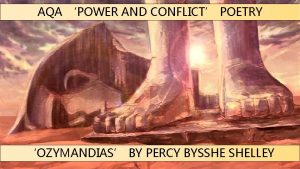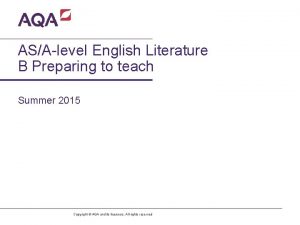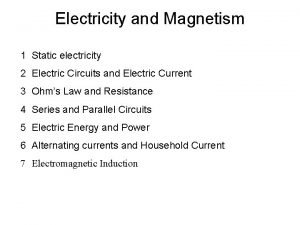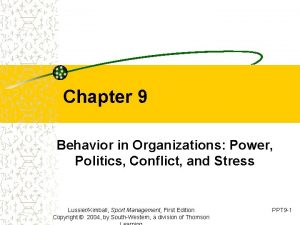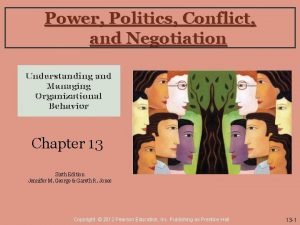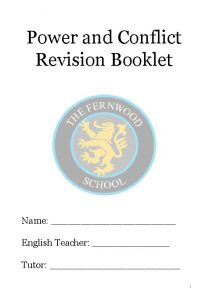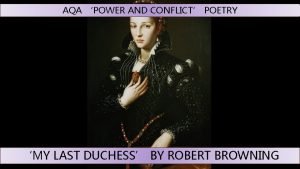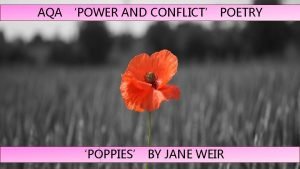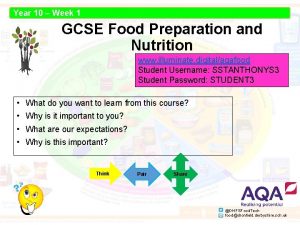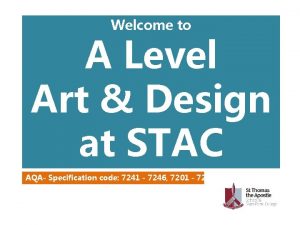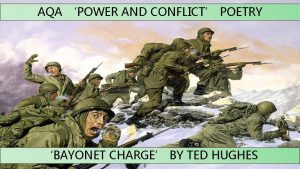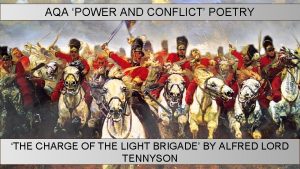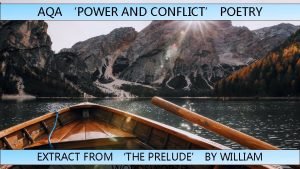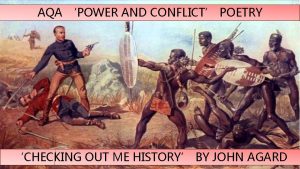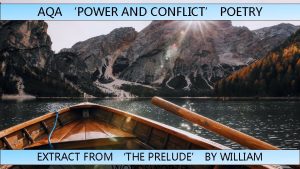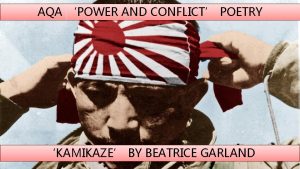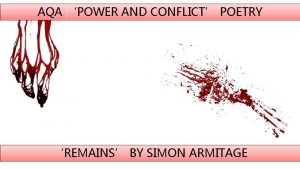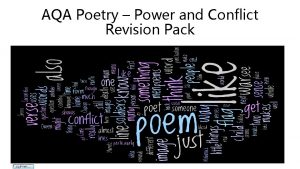AQA POWER AND CONFLICT POETRY THE CHARGE OF

















- Slides: 17

AQA ‘POWER AND CONFLICT’ POETRY ‘THE CHARGE OF THE LIGHT BRIGADE’ BY ALFRED LORD TENNYSON

YOUR STARTER: MAKING INFERENCES FROM ART Consider these paintings. What words best describe the paintings? What big ideas are explored in the paintings? How are the soldiers in these paintings portrayed? Make notes on your sheet and be prepared to share your ideas. TODAY’S KEY QUESTIONS: 1. Can I read, understand respond to the text? 2. Can I analyse language and structure, explaining WHY the writer has used a particular technique and its effect?

CONTEXT: SUMMARISE EACH BULLET POINT - The Crimean War was fought between Britain and Imperial Russia from 1853 -1856. - For the first time in history, newspapers carried eye-witness reports as well as detailing not just the triumphs of war but the mistakes and horrors as well. - The most significant moment in the Crimea came during the Battle of Balaclava. An order given to the British army's cavalry division (known as the Light Brigade) was misunderstood and 600 cavalrymen ended charging down a narrow valley straight into the fire of Russian cannons. - Over 150 British soldiers were killed, and more than 120 were wounded. At home the news of the disaster was a sensation and a nation that had until then embraced British military exploits abroad began to question the politicians and generals who led them. TODAY’S KEY QUESTIONS: 1. Can I read, understand respond to the text? 2. Can I analyse language and structure, explaining WHY the writer has used a particular technique and its effect?

YOUR TASK: THE CONTEXT We are going to read a newspaper article titled, ‘The Charge of the Light Cavalry Brigade’ which reports on the events of the Battle of Balaclava. As we read, underline any words/phrases used to describe the brigade and their actions. Be prepared to discuss how these men are presented. TODAY’S KEY QUESTIONS: 1. Can I read, understand respond to the text? 2. Can I analyse language and structure, explaining WHY the writer has used a particular technique and its effect?

LET’S READ THE POEM Half a league, half a league, Half a league onward, All in the valley of Death Rode the six hundred. “Forward, the Light Brigade! Charge for the guns!” he said: Into the valley of Death Rode the six hundred. “Forward, the Light Brigade!” Was there a man dismay’d? Not tho’ the soldier knew Some one had blunder’d: Theirs not to make reply, Theirs not to reason why, Theirs but to do and die: Into the valley of Death Rode the six hundred. Cannon to right of them, Cannon to left of them, Cannon in front of them Volley’d and thunder’d; Storm’d at with shot and shell, Boldly they rode and well, Into the jaws of Death, Into the mouth of Hell Rode the six hundred. Flash’d all their sabres bare, Flash’d as they turn’d in air Sabring the gunners there, Charging an army, while All the world wonder’d: Plunged in the battery-smoke Right thro’ the line they broke; Cossack and Russian Reel’d from the sabre-stroke Shatter’d and sunder’d. Then they rode back, but not Not the six hundred. Cannon to right of them, Cannon to left of them, Cannon behind them Volley’d and thunder’d; Storm’d at with shot and shell, While horse and hero fell, They that had fought so well Came thro’ the jaws of Death, Back from the mouth of Hell, All that was left of them, Left of six hundred. When can their glory fade? O the wild charge they made! All the world wonder’d. Honor the charge they made! Honor the Light Brigade, Noble six hundred!

YOUR TASK: FIND IT – HIGHLIGHT IT – ANNOTATE IT 1. Lines 1 and 2 – Highlight the language device used in these lines. Name the device and explain its effect. 2. Line 3 – Highlight ‘Valley of Death’ and discuss its connotations. EXTRA CHALLENGE: How is religion alluded to in this line? 6. Line 10. Highlight the language device used in this line and label it. Explain what the question is asking and why Tennyson includes it. What is he saying about the men in the brigade? 7. Line 13. Highlight this line. Why do you think it is slightly indented? What effect does this have? 3. Line 4. Highlight this line. How does Tennyson present the Light Brigade as a collective force here? Why do you think he does this? 8. Lines 13 to 15. Highlight the anaphora in this stanza. Explain why you think it has been used. What is Tennyson suggesting about the men? 4. Lines 5 and 6. Highlight the imperatives in these lines. What is the effect of these? What effect does the punctuation have? 8. Line 15. What is required of the men in the brigade? 5. Lines 5 and 6. Circle the words that belong to a militaristic semantic field. What do these words tell us about this battle? 9. Lines 13 to 15. How does Tennyson create a sense that the soldiers have no control over their fate. 10. Line 17. Highlight ‘six hundred’. Why do you think Tennyson keeps repeating this?

YOUR TASK: FIND IT – HIGHLIGHT IT – ANNOTATE IT 11. Lines 18 to 20 – Highlight these lines. What device does Tennyson use to portray the Russian bombardment? Explain as annotations in your anthology. 12. Lines 18 -20 – Which words in these lines continue to portray the soldiers as an unstoppable force. 13. Line 22. Highlight the verbs and discuss their connotations. How do they present the noises and dangers of the battlefield? 14. Line 22. Highlight this line. Which device has been used? Why? Explain the effect as annotations in the anthology. 15. Line 23. Highlight the adverb and explain how it presents the soldiers in the battle. 16. Lines 24 and 25. Identify the two language devices used in this line and explain their effect. 17. Lines 27 to 30. How is the power of the British presented here? Highlight language used and make notes in your anthology. 18. Lines 30 to 37. Highlight all the verbs in this section. What are the connotations of these verbs? How are the soldiers acting and what does it tell you about their experience? 19. Line 37 to 38. What has happened to the ‘noble six hundred’? 20. Line 39 to 43. Identify the major language devices and word classes used here. Explain their effect as annotations. EXTRA CHALLENGE: Look for where these devices have occurred before. Why repeat them?

YOUR TASK: FIND IT – HIGHLIGHT IT – ANNOTATE IT 21. Line 44. What device has been used here? Why is it used? What does Tennyson want to draw the reader’s attention to? 26. Line 55. Highlight the adjective in this sentence. Discuss its connotations. 27. The entire poem. What could you say about the 22. Line 48 to 49. Tennyson still continues to describe structure of the poem? Why six stanzas? Why are some stanzas longer than others. Discuss as annotations in the men as an unstoppable force. He still refers to your anthology. them as ‘six hundred’ even though many have died. Why do you think he does this? 23. Lines 50 to 55. How has the tone changed here in this final stanza? Why does it change? 24. Line 51 to 52. What is the speaker saying about the charge on reflection? 25. Line 53 to 54. Highlight the imperatives Tennyson uses and explain why he uses them. What does he want this readers to do?

CONSIDER THIS: DACTYLIC DIMETER Now for the meter. This part of the poem's form is definitely less complicated, once you get the hang of it. The first thing we'll look for in each line is which syllables are emphasized. We call that the ‘stress. ’ In general, there are two main stresses in each line of the poem. For example, in Stanza 2, the stressed syllables in bold: bold "Forward, the | Light Brigade!" For Light Was there a | man dismayed? Was man Not though the | soldier knew Not sol Someone had | blundered. Some blun Theirs not to | make reply, Theirs make Theirs not to | reason why, reas Theirs but to | do and die. Theirs do See the pattern there? The stressed syllables come at the beginning and in the middle of the line. They are always followed by two unstressed (or less stressed) syllables. Try saying that first line out loud: "For-ward, the/ Light Bri-gade!" Hear that rhythm? DUM-da-da. TODAY’S KEY QUESTIONS: 1. Can I read, understand respond to the text? 2. Can I analyse language and structure, explaining WHY the writer has used a particular technique and its effect?

CONSIDER THIS: DACTYLIC DIMETER See how we've split the lines up with slashes? In poetry, those little groups of syllables between the slashes are called ‘feet’. When the ‘feet’ look like this – with a stressed syllable followed by two unstressed syllables – we call that a dactyl. When there are two feet dactyl per line, that's called dimeter. So the full, fancy English dimeter teacher name for the rhythm of this poem is dactylic dimeter Perhaps Tennyson uses this rhythm to mirror the thundering of the hooves of the horses. It never falters, just like the soldiers. TODAY’S KEY QUESTIONS: 1. Can I read, understand respond to the text? 2. Can I analyse language and structure, explaining WHY the writer has used a particular technique and its effect?

TO FINISH: CONSIDER THIS IS THE POEM PRO OR ANTI-WAR? NEGATIVE PORTRAYAL OF WAR - ‘valley of Death’ - ‘Someone had blundered. ’ GLORIFYING WAR - ‘Valley of death’ - ‘Boldly they rode and well’ Find quotations that fit into each category. Be prepared to explain whether you think ‘The Charge of the Light Brigade’ is a pro or anti-war poem. TODAY’S KEY QUESTIONS: 1. Can I read, understand respond to the text? 2. Can I analyse language and structure, explaining WHY the writer has used a particular technique and its effect?


RESOURCES

THE CHARGE OF THE LIGHT BRIGADE

YOUR TASK: FIND IT – HIGHLIGHT IT – ANNOTATE IT 1. Lines 1 and 2 – Highlight the language device used in these lines. Name the device and explain its effect. 2. Line 3 – Highlight ‘Valley of Death’ and discuss its connotations. EXTRA CHALLENGE: How is religion alluded to in this line? 6. Line 10. Highlight the language device used in this line and label it. Explain what the question is asking and why Tennyson includes it. What is he saying about the men in the brigade? 7. Line 13. Highlight this line. Why do you think it is slightly indented? What effect does this have? 3. Line 4. Highlight this line. How does Tennyson present the Light Brigade as a collective force here? Why do you think he does this? 8. Lines 13 to 15. Highlight the anaphora in this stanza. Explain why you think it has been used. What is Tennyson suggesting about the men? 4. Lines 5 and 6. Highlight the imperatives in these lines. What is the effect of these? What effect does the punctuation have? 8. Line 15. What is required of the men in the brigade? 5. Lines 5 and 6. Circle the words that belong to a militaristic semantic field. What do these words tell us about this battle? 9. Lines 13 to 15. How does Tennyson create a sense that the soldiers have no control over their fate. 10. Line 17. Highlight ‘six hundred’. Why do you think Tennyson keeps repeating this?

YOUR TASK: FIND IT – HIGHLIGHT IT – ANNOTATE IT 11. Lines 18 to 20 – Highlight these lines. What device does Tennyson use to portray the Russian bombardment? Explain as annotations in your anthology. 12. Lines 18 -20 – Which words in these lines continue to portray the soldiers as an unstoppable force. 13. Line 22. Highlight the verbs and discuss their connotations. How do they present the noises and dangers of the battlefield? 14. Line 22. Highlight this line. Which device has been used? Why? Explain the effect as annotations in the anthology. 15. Line 23. Highlight the adverb and explain how it presents the soldiers in the battle. 16. Lines 24 and 25. Identify the two language devices used in this line and explain their effect. 17. Lines 27 to 30. How is the power of the British presented here? Highlight language used and make notes in your anthology. 18. Lines 30 to 37. Highlight all the verbs in this section. What are the connotations of these verbs? How are the soldiers acting and what does it tell you about their experience? 19. Line 37 to 38. What has happened to the ‘noble six hundred’? 20. Line 39 to 43. Identify the major language devices and word classes used here. Explain their effect as annotations. EXTRA CHALLENGE: Look for where these devices have occurred before. Why repeat them?

YOUR TASK: FIND IT – HIGHLIGHT IT – ANNOTATE IT 21. Line 44. What device has been used here? Why is it used? What does Tennyson want to draw the reader’s attention to? 26. Line 55. Highlight the adjective in this sentence. Discuss its connotations. 27. The entire poem. What could you say about the 22. Line 48 to 49. Tennyson still continues to describe structure of the poem? Why six stanzas? Why are some stanzas longer than others. Discuss as annotations in the men as an unstoppable force. He still refers to your anthology. them as ‘six hundred’ even though many have died. Why do you think he does this? 23. Lines 50 to 55. How has the tone changed here in this final stanza? Why does it change? 24. Line 51 to 52. What is the speaker saying about the charge on reflection? 25. Line 53 to 54. Highlight the imperatives Tennyson uses and explain why he uses them. What does he want this readers to do?
 What poem does ozymandias link to
What poem does ozymandias link to Aqa a level english literature b past papers
Aqa a level english literature b past papers Difference between charge and electric charge
Difference between charge and electric charge Difference between charge and electric charge
Difference between charge and electric charge Power triangle formula
Power triangle formula External conflict definition
External conflict definition What is conflict and conflict resolution?
What is conflict and conflict resolution? One subcategory of external conflict is
One subcategory of external conflict is Voltage and energy relationship
Voltage and energy relationship Electric current in water
Electric current in water What is a lyrical poem
What is a lyrical poem Power, politics and conflict in organizations
Power, politics and conflict in organizations Power, politics and conflict in organizations
Power, politics and conflict in organizations Power and conflict revision booklet
Power and conflict revision booklet My last duchess structure and form
My last duchess structure and form Poppies by jane weir analysis
Poppies by jane weir analysis Illuminate aqa food preparation and nutrition
Illuminate aqa food preparation and nutrition Aqa a level art and design
Aqa a level art and design
